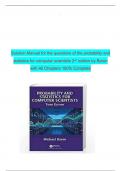Tentamen (uitwerkingen)
Solution Manual for the questions of the probability and statistics for computer scientists 2nd edition by Baron with All Chapters 100 Complete_compressed
- Vak
- Instelling
- Boek
Solution Manual for the questions of the probability and statistics for computer scientists 2nd edition by Baron with All Chapters 100 Complete_compressed
[Meer zien]




